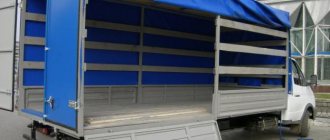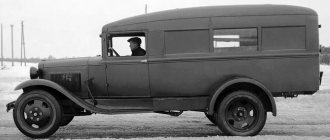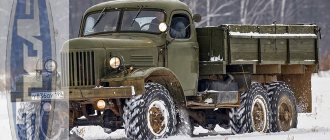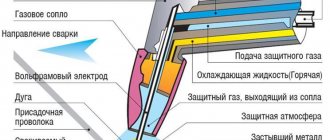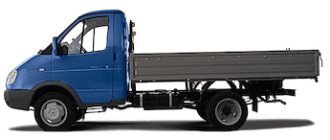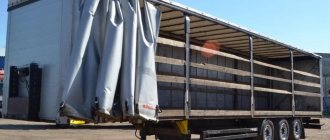GAZ-56 Soviet experimental truck
In the early 1950s, the production of GAZ-MM
- the then only truck with a carrying capacity of 1.5 tons - had already been completed at the last manufacturing plant in Ulyanovsk.
The modernized “lorry” was already a fairly outdated vehicle at that time, but still had stable demand in the national economy, especially in rural areas. And there was no alternative to it yet. Designed back in 1938 at GAZ, the new basic model GAZ-11-51
, although at first it resembled a “lorry” with wheels and chassis, was already “two-thin”, and then was completely transformed into a structurally different and heavier GAZ-51 .
The next attempt to create an updated “lorry” was the Ulyanovsk experimental 1.5-ton UAZ-302, created in November 1950 on the basis of the UAZ-300 pickup truck, designed for 750 - 800 kg. However, both cars remained experimental models: in 1951, the Ulyanovsk Automobile Plant was transferred to another industry (until 1955 it was listed as a military radio plant), so they could no longer produce the “one and a half”, much less modernize its capabilities. Therefore, at the beginning of 1952, the Gorky residents themselves returned to this idea, when, after mastering and eliminating problems with the first post-war models, they began to design promising machines. One of these bright and original developments was the new “one and a half” GAZ-56, the impetus for the creation of which was an analysis of foreign trends (the growth in the production of light-duty trucks in Europe) on the one hand, and the absence of such a model in the USSR on the other. The conclusion was that in addition to the 2.5-ton GAZ-51, a more compact, economical and lightweight truck with a capacity of 1.5 tons of cargo
.
Design of the first models
The car was designed by sculptor B.B. Lebedev. An interesting fact is that he sculpted a full-size model of the cabin from plasticine.
Two styling options were proposed:
- Early, which was distinguished by “low” wings. This option was subsequently criticized for poor functionality. At the same time, the driver did not feel the dimensions of the GAZ-56 car. The cabin had well thought out proportions. This part looked great with the truck bed. It made the car more compact.
- Late, which is characterized by a cabin design similar to the GAZ-53. But this option was considered unsuitable in terms of dimensions.
GAZ-56 1952 I-series
photo of GAZ-56 1st series
On April 27, 1952, the ministry approved the technical specifications for the 1.5-ton GAZ-56, and the then chief designer of GAZ, L.V. Kostkin, gave the go-ahead for its development. At an early stage, work on the “56th” was carried out by S. B. Mikhailov and B. I. Shikhov, and from August 1954, A. M. Butusov, a recent graduate of the Gorky Polytechnic, became the leading designer of the machine. This was the young designer’s first serious task after designing caravans. The first version of GAZ-56
to a large extent became a further development of the UAZ-302, and this is natural, since its design was created mainly by Gorky residents (until 1950, the UAZ was considered only a car assembly), and then all the developments on it ended up here.
Even externally, the cars were very similar: V-shaped hoods (made, by the way, integral with the lining), “blown” fenders in the “American” style of the 1940s, 2-seater streamlined metal cabins with V-shaped windshields, identical layout headlights In a word, the external differences between the “ 56th
” and “302nd” were reduced only to a different design of the radiator lining and a slightly modified cabin. Instead of horizontal slots in the UAZ cladding, designer Lebedev decided to use vertical slots on the GAZ-56 and simplify the cabin contours somewhat.
photo of UAZ-300
It must be admitted that if the 1-ton UAZ-300 model of 1949 with its single-pitch “passenger” wheels was more reminiscent of an American pickup truck of those years, then both the “302nd” and the “56th” were already, albeit lightweight, but full-fledged trucks. One of the weakest points of the UAZ-302 was the 4-cylinder engine borrowed from Pobeda with only 50 hp, which, as they say, “barely carried it” (the dynamic factor was only 0.309). The gearbox was developed with its own, three-way, 4-speed gearbox, which with modifications was then “migrated” to the GAZ 56, although its range was still too small. Engine GAZ 56
, if we take into account the “Pobedovsky” (with a “minuscule” torque of 3.5 kg/m) and was installed on the GAZ-56, then only on the 1st model, and the 2nd and 3rd have already been equipped with still experienced, “raw” and capricious, but still with 70-horsepower GAZ-21 engines.
The chassis of the “302” and the early “56” also had a lot in common: the same wheels, borrowed from the GAZ-MM, similar axles, wheelbase sizes, side platforms... Overall dimensions
GAZ-56(I) were: 5085 mm in length, 2172 mm in width and 1995 mm in height, the wheelbase was 2950 mm, and the rear and front wheel tracks were 1650 and 1472 mm, respectively. Load capacity on the ground was reduced to 1300 kg. Its own weight reached 1848 kg, the highest speed was 82 - 83 km/h, and fuel consumption was 15 l/100 km. The early GAZ-56 was distinguished by good ground clearance: under the rear axle its value was 240 mm, and under the front axle, thanks to the “German” solution of its “swivel” units, as much as 345 mm!
photo of GAZ-56 1st series
Other design features of the 1st “56th” include two oil filters (coarse and fine with a replaceable element identical to the GAZ-51), an accordion-type thermostat, a tubular 3-row radiator with shutters, a dry single-plate clutch, a single open driveshaft on needle bearings, GP made of a pair of bevel gears with spiral teeth and a gear ratio of 6.5:1, cam limited slip differential, tires of size 6.50-20, suspension on 4 longitudinal semi-elliptic springs. Interestingly, the ends of the springs were already embedded in rubber cushions, and double-acting hydraulic piston shock absorbers were also installed on the front axle. The car used a steering mechanism of the “globoidal worm and double roller” type, a steering wheel with a diameter of 400 mm (like the Moskvich-407), hydraulic brakes, 12-volt electrical equipment, heating and ventilation of the cabin. Some samples had a steel camshaft (on five bearings), while others had a cast iron camshaft.
photo of GAZ-56 1st series
Well-designed proportions allowed the 1st version of the GAZ-56 to become a truly compact, maneuverable (turning radius of only 6.5 m) and attractive truck, with good off-road capabilities (longitudinal cross-country radius - 2.2 m; overhang angles: front - 45 hail, rear - 30 degrees), and the then modern design of the front end with headlights and sidelights from Pobeda emphasized the novelty and promising image of the model. By the way, they were already thinking of using a similar appearance for further modernization of the GAZ-51: a 1953 prototype with a similar tail is known. E. I. Prochko recalls: “At the end of July 1953, in the experimental workshop of GAZ there was already a wooden and plasticine model of GAZ
-56 life-size (next to a similar model of the first Volga).
And at first glance, the truck seemed so pretty, so neat, that it aroused emotion among the members of the military commission. The officers present immediately noted the similarity of the car to the Lend-Lease Ford 6
, which was familiar to many at the front and was still seen on the roads then.”
In the summer of 1953, no one was messing around with the “56” model anymore, as work began on the first model of the machine “in metal.” Contrary to popular dating, it was ready by the end of the same 1953, when N.I. Borisov was the “chief” at GAZ, and at the beginning of the next year it was already being fully tested. From the GAZ report on work performed in 1954: “On GAZ-56. Two samples of the 2nd series were produced. Factory tests of the 1953 model were carried out. The total mileage is 36 thousand km.” Samples of the GAZ-56(I) 2nd series went on road tests in 1955. One of the distinctive features was the use on these and subsequent vehicles of the 1st version, sealed drum brakes, developed for the GAZ-62 all-terrain vehicle, unified with the “56th”. On the GAZ-56, outwardly this “resulted” in different rims with caps of a very unusual type for those years. However, during operation, it turned out that such brakes “worn themselves out”: the abrasive dust that accumulated inside greatly accelerated the wear, primarily of cast iron drums. The 56th had no need for such a unit; this was only a consequence of unification. After all, both the “heavy jeep” GAZ-62, the first version of which appeared in 1952, and the GAZ-56 model of 1954, according to the technical design, were unified with each other not only in brakes, but also in all main units: engine, side members and most frame cross members, elements of the rear axle, suspension and much more.
In addition to new brakes, on samples of the 2nd series of GAZ-56(I), rounded stamped fenders were added above the rear wheels, and stiffening bars on the side sides of the body were strengthened. A little later, the wooden side platform was replaced with a metal one with neat sides and stiffening ribs in them, and at the same time the rear fenders were replaced with simpler bent mudguards. It was in this form that the sample of the 3rd series was exhibited in 1956 - 1957 in Moscow at the All-Russian Exhibition Center (VDNKh), and became the most famous of all samples of the 1st version of the GAZ-56. Its characteristics were published in reference books, photos in magazines, and images even “leaked” onto the match labels of the Gigant factory of the Kaluga SNH in 1958.
In general, the car turned out to be good and necessary, but the prospect of its mass production remained vague. The fact is that each of the three basic models created almost in parallel at that time - the Volga GAZ-21, GAZ-62(I) and GAZ-56(I), required significant new production capacities for production, and these were at the plant, where the GAZ-51, -63, -69, Pobeda, ZIM, BTR-40, tracked GAZ-47 and other vehicles were already being produced at maximum load, there was just not enough. The military did not show due persistence in ordering the “Soviet Dodge” - the early GAZ-62, and together with it they “wrapped up” the 1st version of the GAZ-56, unified with it. In 1957, work on it was no longer carried out, although the car was still presented as promising.
The closest “kinship” of the GAZ-56 (in frame, engine, gearbox, clutch, rear axle beam, cardan shafts, suspension, wheel hubs and bearings, etc.) was assumed to be with the cabover GAZ-62. And from “52/53”, at all costs, they were required to take the already created cockpit and tail, which continued the development of the American style of the 1950s, although for the “56th” they, naturally, turned out to be too big and heavy.
Comparison with the "three hundredth"
GAZ-56 was developed on the basis of the VAZ-300 car. Both models had identical axles and identical five-stud wheel hubs. True, their disks were different. The VAZ-300 was equipped with wheels that had the rim profile of passenger cars. And its rear wheels were single-pitch. But on GAZ standard wheels with “windows” were installed.
The cabin was also slightly different between the two models. If the “300th” had horizontal cladding slots, then the 56th had them made vertical. The hanging elements themselves were more rational and simpler. And this is not surprising, because the GAZ-56 was developed from the very beginning as a truck. And the UAZ resembled an American pickup truck, created from a passenger car.
GAZ-56 1958 II series
photo of GAZ-56 2-series
So, at the turn of 1958 - 1959, the 2nd version of the GAZ-56
, which, despite the most modern forms, looked more unsightly and “underdeveloped” compared to the first. The large cabin and front end did not really fit into the low landing and relatively small dimensions of the car. The dimensions of the 2nd version increased slightly: the length was now 5350 mm, width - 2175 mm, height - 2030 mm. The wheelbase (3000 mm), the front wheel track (1590 mm) and the area of the side platform (5.64 sq.m instead of 5.11 sq.m) have become slightly larger. But the weight of the GAZ-56(II) without load increased to 2030 kg, as a result of which the tare coefficient became worse than that of the GAZ-AA. Dynamic qualities, cross-country ability parameters (clearance - 230 mm), and turning radius (7 m) have deteriorated. The price of unification was so high.
On GAZ-56
model 1959 - 1960 were used: a dry single-plate clutch, a new 4-speed gearbox with synchronizers in the 3rd and 4th gears (by the way, very unsuccessful) and other gear ratios, two cardan shafts with an intermediate support, hydraulic brakes etc.
Fuel consumption compared to the 1st option increased to 16 l/100 km, which, with an 80-liter gas tank (in the 1st option - by 85 l), reduced the range from 565 to 500 km. An important innovation on the later GAZ-56s was the one-piece rear axle
of the “banjo” type with a plug-in gearbox with a hypoid final drive (gear ratio - 6.5) and completely unloaded axle shafts.
Our drivers were familiar with such a unit only from some Lend-Lease cars. Therefore, it was especially emphasized that for its maintenance it is strictly forbidden to use any lubricant other than a special hypoid one, which also applied to the rear hubs. The car was now equipped with a bevel differential, but some samples intended for difficult conditions were planned to be equipped with a self-locking cam upon request. The towing device was also supposed to be installed only upon request, because the total weight of the towed trailer was only 1,700 kg, and it is unlikely that the “56th” with a trailer would be seriously applicable in practice. Instead of spring pins, rubber cushions were also used, and in addition to springs at the front there were also hydraulic telescopic shock absorbers (they were also supposed to be at the rear, but only by special order). In 1960, samples of GAZ 56
(II) entered interdepartmental (i.e., state) tests. The run with representatives of various research institutes simulated a warranty run of about 25,000 kilometers, and lasted six months: from January 10 to June 1. In addition to the “56s” in the convoy were a GAZ-51A, a GAZ-62 and two 1.5-ton foreigners from the late 1950s: a Ford Mercury 350 and an Opel Blitz. The tests took place along the highways of Central Russia, mountain serpentines of the Caucasus, washed-out black earth country roads of Stavropol and other regions of the country.
The 2nd version of the GAZ-56 performed well overall. Its frame was stronger than that of foreign cars, and the springs worked more reliably. However, under difficult operating conditions, the electric coupling of the fan could not cope with cooling, and the engine itself, as the commission especially emphasized, was characterized by insufficient power. Generally the engine
GAZ-56 required constant attention and “gentle” handling from the driver, especially during break-in. It was impossible to boost it further by increasing the compression ratio, as was done on export Volgas, because in the country the norm was “66th” grade of gasoline. There were other still “raw” places: not very reliable hubs, spring mountings, a “leaking” rear axle. And although the plant intended to provide a 6-month warranty for the GAZ-56 subject to a mileage of no more than 25,000 km, the mandatory requirements of the manufacturer at first were constant daily inspections of the car and thorough maintenance. However, the GAZ-56(II) was considered worthy of mass production. It was exhibited at VDNKh, they wrote about it in the press (although sometimes confused with the GAZ-52 created in parallel), they began to be mentioned in the literature, erroneously indicating that it was already being produced, and supposedly with a pre-chamber-torch engine (Dolmatovsky and Trepenenkov reference book, 1960 year). In fact, these capricious engines could not be “brought to mind”, so almost all samples of the later GAZ-56 had GAZ-21 power units. Moreover, in the same 1960, the GAZ printing house, edited by A.D. Prosvirnin, published detailed 112-page “Care Instructions”, since there had not yet been a shadow of doubt about the release of “56(II)”.
But production, meanwhile, was postponed and then completely closed. Several reasons were given. Without significant investments, the plant could not master the production of two new trucks at once - GAZ-53 and GAZ-56. In addition, in the USSR they again began to strongly advocate for increasing payload capacity, and even the 2.5-ton GAZ-52 was thoroughly (almost for 10 years!) “delayed” in the pre-production ones, “skipping” ahead of “53F”, “53”, and "53A". What can we say about the “lorry” that didn’t get into the flow? But the main and decisive circumstance was the sudden and voluntaristic refusal of the military leadership from the cabover GAZ-62 (which had been in production for more than a year!): the “cross” on the “62nd” was automatically crossed out by the GAZ-56(II), again widely unified with it.
At the beginning of 1962, all further work on the GAZ-56 was stopped.
photo of GAZ-56
photo of GAZ-56 dump truck
Tests and improvements
The Soviet truck GAZ-56 began to be tested already in 1956. Of course, there were shortcomings, and there were many of them. But overall this car was not bad.
The very first improvements affected the braking system. Drum brakes were installed. This led to the need to install new rim shapes. The wooden platform was replaced with a metal one with stiffening ribs. It was covered with low metal sides. The rear fenders were replaced with bent mudguards.
The car turned out to be quite good. But there was one drawback that reduced the likelihood of mass production. And this was not the designers' mistake. It was a manufacturing flaw. It consisted in the fact that the car was very different from other models of the manufacturer. Therefore, it was decided to unify the vehicle.
Notes
| : Incorrect or missing image | To improve this article it is desirable:
|
| This is a preliminary article about cars. You can help the project by adding to it. |
| GAZ buses | GAZ-03-30 • GAZ-05-193 • GAZ-55 • GZA-651 • “GAZelle” • “GAZelle-Business” • “Sobol” • “GAZelle-Next” |
| GAZ special equipment | GAZ-VM • GAZ-46 • Half-track vehicle based on GAZ-63 • GAZ-47 (GT-S) • GAZ-71 (GT-SM) • GAZ-34039 • GAZ-34039 “Irbis” • GAZ-34039K “Irbis” » • GAZ-3409 “Beaver” • GAZ-3344 • GAZ-3351 • “Tiger” • GAZ-3937 • GAZ-5903 (BTR-80) • GAZ-59039 (BMM-80) • GAZ-5903V “Vetluga” • GAZ-5903Zh • GAZ-59402 “Blizzard” |

